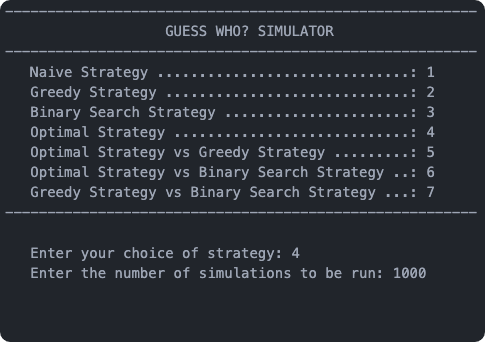This project determines the best way to play the game Guess Who?
Guess Who? is a board game in which the objective is to guess the opponent's character. Each player picks a character from a group of 24 characters, and then take turns asking yes or no questions, until one of them guesses the opponent's character.
In this project, 4 different strategies are tested, by simulating games of Guess Who? and having different strategies face off against each other.
This strategy is the one adopted by most people playing the game. There is no logic or foresight involved, and questions are asked randomly.
This strategy involves asking questions based on the expected number of characters left after asking the question. This is calculated by obtaining the sum of the product of the probability of a character having a certain trait and the number of characters with that trait and the product of the probability of a character not having that trait and the number of characters who do not have that trait.
For example, for the question "Does your character wear Earrings?", the expected number of players left would be:
The Greedy Strategy always asks the questions with the lowest Expected Number of Remaining Players metric.
This strategy is called The Greedy Strategy because it makes the best choice for a single turn, while disregarding future options. The lack of foresight prevents this strategy from being too successful.
The Optimal Strategy takes from the Greedy strategy, by asking questions that would result in the fewest remaining characters, and also maintains a Tree that stores the fastest route to victory from every possible scenario, when the Player's first question is "Does your character have a big mouth?". This question is the best question to ask in terms of the expected remaining players.
The Binary Search Strategy is based on repeatedly asking a question that halves the expected remaining players. This is done by asking questions like "Does the first letter of your character's name come after H in the alphabet?".
Since there are 24 possible characters to begin with, using this strategy, a Player can win in at most 5 turns.
While this strategy technically doesn't break any rules of the game, it is definitely not the way the game was meant to be played.
The code for this project was written in Python 3.
All the character information is stored in a csv file guess_who_characters_x.csv
The program receives the number of games to be simulated and the strategy to be applied from the user.
When a game is simulated, the program reads the csv file and creates a list of Character objects. It then initialises two Player objects, based on the strategy selected in the menu. After each Player is given a secret character which must be guessed by their opponent, the program begins alternating between players so that they can each ask a question to their opponent.
The program randomly decides which player gets the first turn. This is important, as the player who starts typically has a 5% higher chance of winning, when playing the Naive and Greedy strategies. However, when playing the Optimal and Binary Search Strategy, this chance increases significantly.
Each Player maintains a list of characters self.__list_of_characters which contains all the characters that the opponent could have. Based on responses to the Player's questions, Characters are removed from this list.
When only one Character remains in the list, i.e. the opponent's possible characters is narrowed down to one character, the game ends. The first player to narrow down their list to to one Character is the winner.
The given number of games of Guess Who? are simulated, and each Player's wins are counted. The program displays the results.
The menu upon starting the program:
The result at the end of execution:
How a game of Guess Who? is represented:
The Binary Search Strategy is found to be the most effective, beating the second best - The Optimal Strategy - 60% of the time.
Since the Binary Search strategy could be construed as illegal, the Optimal Strategy is the most recommended, beating the Greedy and Naive strategies roughly 85% of the time.
Being a highly random game, the only way to really win a game of Guess Who? every single time is to cheat. However, if the situation ever arises where one has to play a game of Guess Who? for their life, then adopting one of the aforementioned strategies may not be such a bad idea :)
-
A youtube video by Mark Rober. His strategy is essentially the same as the Binary Search Strategy, however his questions are different. He eliminates half the possible characters by combining questions, for example, "Does your character have Black hair or Blue Eyes or a big nose?"
-
An article by Rafael Prieto Curiel. This article brushes over Decision Theory and led me to the Optimal Strategy.




